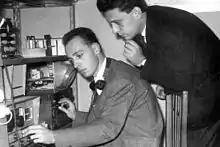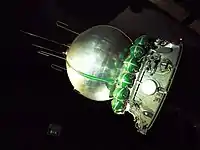Judica-Cordiglia brothers
The Judica-Cordiglia brothers are two Italian former amateur radio operators who made audio recordings that allegedly support the conspiracy theory that the Soviet space program covered up cosmonaut deaths in the 1960s. The pair claimed to have acquired recordings of several secret Soviet space missions that ended in tragedy and mystery. This has generated public interest for more than 50 years,[1] despite there being a large number of detailed rebuttals to the brothers' claims.[2]


Background
Achille (1933 - 2015) and his brother Giovanni Battista (born 1939) set up their own experimental listening station just outside Turin in the late 1950s. The brothers used a disused German bunker at a site named Torre Bert. Working with scavenged and improvised equipment, they claimed to have successfully monitored transmissions from the Soviet Sputnik program and Explorer 1, the first American satellite, using equipment that recorded flight information such as telemetry, voice recordings and visual data.
Recordings
In the 1960s, the brothers claimed to have heard radio communications taken from secret Soviet Union space missions, including the dying sounds of a suffocating "lost cosmonaut". One of their most famous recordings was made on 28 November 1960. After about an hour of listening to static, the brothers recognised an SOS signal that seemed to be moving away from the Earth. The story was picked up by a Swiss-Italian radio station and the brothers became the station’s space experts.
In November 1963, the brothers said they recorded the voice of a female cosmonaut re-entering the Earth's atmosphere in a malfunctioning spacecraft; in the recording she is heard to have cried out, "I am hot" as it burnt up.
In total the Judica-Cordiglia brothers released nine recordings over a period of four years. The details were as follows:
- May 1960, a crewed spacecraft reports it is going off course.
- November 28, 1960, a faint SOS Morse Code signal is sent from another troubled spacecraft leaving Earth's orbit.[3]
- February 1961, a cosmonaut is audibly recorded suffocating to death.
- April 1961, a capsule is recorded orbiting the Earth three times before re-entering the Earth’s atmosphere just days before Yuri Gagarin made his historic flight.
- May 1961, an orbiting spacecraft makes an appeal for help after going out of control.
- October 1961, a cosmonaut loses control of his spacecraft which veers off into deep space.
- November 1962, a space capsule misjudges re-entry bouncing off the Earth’s atmosphere and out into space.
- November 1963, a female cosmonaut dies during re-entry.
- April 1964, another cosmonaut is killed when his capsule burns up in the Earth's atmosphere.
Since the 1960s critical analysis of the recordings has cast doubt on their provenance. For instance, audio transcripts reveal that none of the cosmonauts, who were supposed to be Soviet air force pilots, followed standard communication protocols, such as identifying themselves when speaking or using correct technical terminology.[4] Likewise all the recordings contain disjointed sentences and grammatical errors (e.g. the meaningless "..аша передача будет сейчас", Nov 1963)←(″аша передача будет сейчас″ Translation: "...[o]ur transmission will now...") contradicting the known fact that the Soviet space program only used highly trained, well-educated Russian native speakers from aeronautical backgrounds.[5] Though some of the transcripts record cosmonauts saying they are leaving Earth's orbit (i.e. heading into interplanetary or "deep" space), the crewed Vostok 3KAs could not reach escape velocity because their designs never contained secondary-burn propulsion units. This was inherent to the Vostok programme, a project to put the first Soviet citizens into low Earth orbit and return them safely. OKB-1 only required spacecraft with velocities that could reach Earth orbit (28,160 km/h or 17,500 mph) far less than the speed needed to break orbit (40,320 km/h or 25,050 mph). Propulsion units powerful enough to leave Earth's orbit did not begin to appear until the test firing of the RD-270 engine in 1969; and it was not until the N1 moon rocket (with the NK-33 engines) in 1974 that the Soviets built a spacecraft able to reach open space.[6][7] It is impossible to "accidentally" veer off into deep space without firing a rocket engine powerful enough to accelerate to escape velocity.
Legacy
In 1964 they won the Italian TV quiz show Fiera dei Sogni ('The Fair of Dreams') that enabled them to visit NASA as their prize.
Their 1963 recording of the female cosmonaut was repurposed and to be used in the video game Half-Life 2, but was cut at some point during development. It can be heard in the leaked beta level "hazard01" and in the official teaser trailer "Psyche."
In 2007 the brothers were the subject of a documentary called I pirati dello spazio (known in English as 'Space Hackers'). Fortean Times, a science-sceptical magazine, published an article on the brothers and their recordings of lost cosmonauts in March 2008. A sympathetic dramatisation of the brothers' story, called "Listen Up" by Glen Neath, was broadcast on BBC Radio 4 in May 2009. In 2011, the brothers' story was featured on the Science Channel TV show, Dark Matters: Twisted But True.[3] The Dark Matters Season 01 Episode 05 also presented the story in an extremely sympathetic light, only briefly mentioning any skepticism that exists.
In later life, Achille became a cardiologist while Giovanni Battista worked for the Italian police providing phone-taps in criminal investigations.
References
- "Lost in Space". Fortean Times. July 2008. Retrieved 8 June 2013.
- "Lost Cosmonaut Rumors". aerospaceweb.org. Retrieved 8 June 2013.
- Dark Matters: Twisted But True - "Missing Cosmonauts" Episode, 2011, television show, Science Channel, aired December 14, 2011 8-9am MST
- Notes on the space tracking activities
- Andrews & Asif A. Siddiqi, James T. (2011). Into the Cosmos: Space Exploration and Soviet Culture. University of Pittsburgh. ISBN 9780822977469.
- Asif. A. Siddiqi (2000). Challenge to Apollo: The Soviet Union and the Space Race, 1945-1974. NASA. SP-2000-4408. Part 1 (page 1-500), Part 2 (page 501-1011)
- Rex Hall, David Shayler (May 18, 2001). The rocket men: Vostok & Voskhod, the first Soviet manned spaceflights. Springer. p. 350. ISBN 1-85233-391-X.
Further reading
External links
- Readers' Digest Article
- Fortean Times Article
- I Pirati Dello Spazio (Pirates of Space) on YouTube Italian film on Judica-Cordiglia Brothers